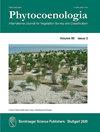Community structure and diversity of vegetation and flower-visiting wild bees (Hymenoptera: Apoidea) in sandy dry grassland: are there congruent characteristics?
IF 0.9
4区 生物学
Q4 ECOLOGY
引用次数: 9
Abstract
We studied community structures of mainly threatened types of sandy dry grassland, and those of flower-visiting wild bees, in successional, non-ruderal or ruderal gradients in the Upper Rhine Valley (Germany). We searched for congruent characteristics in the floristic/faunistic structure of plant and bee species, and for differences between two study years. We also asked which vegetation type or complex plays the most important role as a pollen or nectar resource for wild bees, and what conclusions can be drawn for nature conservation. The vegetation types or complexes range from basiphytic pioneer stages to consolidated basiphytic to slightly acidophytic grasslands (classes Koelerio-Corynephoretea and Festuco-Brom- etea): Koelerion glaucae complex (1), Armerio-Festucetum trachyphyllae (2a, typical; 2b, ruderalized), ruderalized ex-arable field (3), and Allio-Stipetum capillatae (4). We used a plot-based approach for recording vegetation data and flower-visiting wild bees. Releves were sampled and flower- visiting bees netted on defined flower resources (2004, 2005). Data were analyzed by ordination, mixed linear models and regres- sion analysis. Phytosociological table and DCA show clear floristic differentiations between the vegetation types and complexes. For the bee data there were weaker species-based differentiations. In the year 2004 there were two bee assemblages, in the year 2005 this dif- ferentiation was not detectable. The most species- and individual-rich wild-bee populations were detected in the vegetation types 2b, 3 and 4. These types were characterized by a high diversity of entomophilous plant species in combination with high flower density. Although ruderalized sandy grasslands have only moderate conservation value based on vegetation characteristics, they offer remarkable resources for species-rich populations of wild bees. Important flower resources for endangered wild-bee species are, among others, Centaurea stoebe s.l., Berteroa incana and Carduus nutans. The diversity characteristics of the studied vegetation types or complexes do not always correspond to those of the flower-visit- ing bees, which should be taken into account in developing conservation strategies.沙质干燥草原植被与访花野蜂群落结构与多样性:是否有一致的特征?
研究了德国上莱茵河谷地区主要受威胁的沙质干草地类型和访花野蜂群落结构在演替、非野性和野性梯度上的变化。我们寻找植物和蜜蜂物种的区系/区系结构的一致性特征,以及两个研究年份之间的差异。我们还询问了哪种植被类型或复杂的植被对野生蜜蜂的花粉或花蜜资源起着最重要的作用,以及可以得出哪些结论来保护自然。植被类型或复合体的范围从基生先驱阶段到固结基生到微酸生草地(Koelerion - corynephoretea和Festuco-Brom- etea类):Koelerion glaucae复合体(1),Armerio-Festucetum trachyphyllae (2a,典型;2b,粗糙化),粗糙化耕地(3)和毛毛Allio-Stipetum capillatae(4)。我们使用基于标绘的方法记录植被数据和访花野生蜜蜂。在一些特定的花卉资源上采集样本和访花蜜蜂(2004,2005)。数据分析采用排序、混合线性模型和回归分析。植物社会学表和DCA显示了植被类型和复合体之间明显的区系差异。对于蜜蜂数据,基于物种的差异较弱。在2004年有两个蜜蜂组合,在2005年这种分化没有被检测到。野生蜜蜂种群数量和个体数量最多的是植被类型2b、3和4。这些类型的特点是昆虫植物种类多样性高,花密度高。粗糙化的沙质草地虽然具有中等的保护价值,但却为种类丰富的野生蜜蜂种群提供了可观的资源。对濒危野生蜜蜂来说,重要的花卉资源有半人马花(Centaurea stoebe s.l)、白桦花(Berteroa incana)和胡桃花(Carduus nutans)。研究的植被类型或复合体的多样性特征并不总是与访花蜜蜂的多样性特征相对应,在制定保护策略时应考虑到这一点。
本文章由计算机程序翻译,如有差异,请以英文原文为准。
求助全文
约1分钟内获得全文
求助全文
来源期刊

Phytocoenologia
生物-植物科学
CiteScore
2.60
自引率
0.00%
发文量
7
审稿时长
>12 weeks
期刊介绍:
Phytocoenologia is an international, peer-reviewed journal of plant community ecology. It is devoted to vegetation survey and classification at any organizational and spatial scale and without restriction to certain methodological approaches. The journal publishes original papers that develop new vegetation typologies as well as applied studies that use such typologies, for example, in vegetation mapping, ecosystem modelling, nature conservation, land use management or monitoring. Particularly encouraged are methodological studies that design and compare tools for vegetation classification and mapping, such as algorithms, databases and nomenclatural principles. Papers dealing with conceptual and theoretical bases of vegetation survey and classification are also welcome. While large-scale studies are preferred, regional studies will be considered when filling important knowledge gaps or presenting new methods.
 求助内容:
求助内容: 应助结果提醒方式:
应助结果提醒方式:


